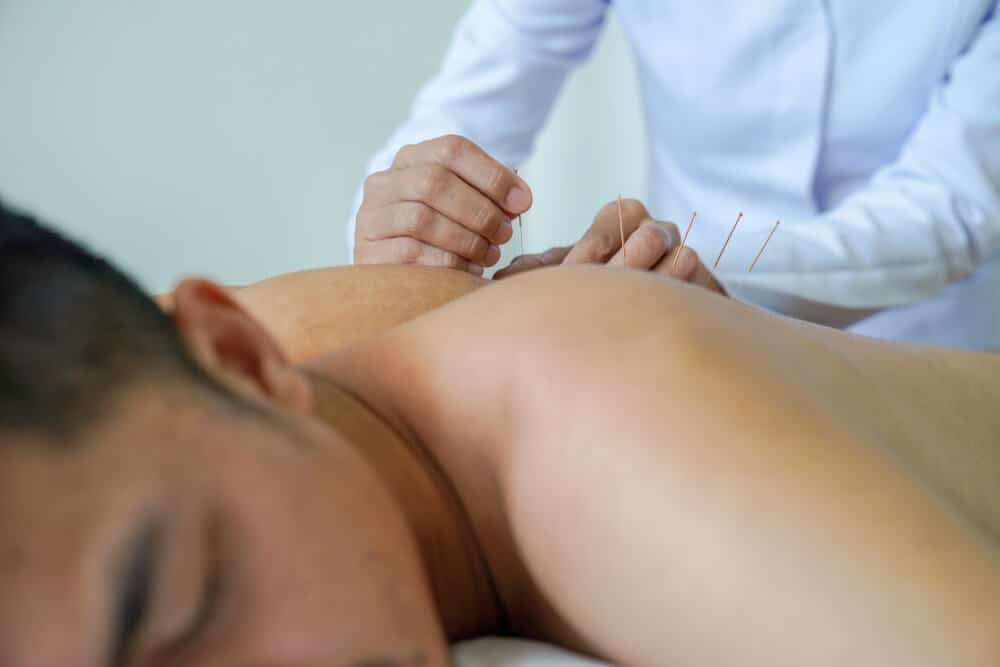From mobility struggles and aching muscles to poor circulation and chronic pain, dry needling trigger point therapy can be a highly effective part of larger treatment plans for many complex physical issues.
So, what exactly is this drug-free method of treating musculoskeletal pain, and how does dry needling work?
What Is Dry Needling And How Does It Work?
Dry needling, sometimes known as clinical acupuncture, involves the placement of acupuncture needles into carefully chosen trigger points.
Known as dry needling – with nothing injected into the tissue unlike injection needling – it’s used to treat muscle and pain issues in the legs, arms, neck, shoulders, back, ankles, and headaches.
What Is Dry Needling?
The technique of dry needling involves the insertion of single-use micro-fine needles into knotted areas of muscle known as myofascial trigger points to relieve tension, minimise muscle irritability, and reduce pain.
An experienced practitioner will examine the painful or achy areas in question before asking you to relax, inserting the needle, and leaving it there for up to 10 minutes depending on tension severity. More specific approaches, such as trigger point dry needling, may be appropriate based on your symptoms.
How Does Dry Needling Work?
As each micro-fine needle is placed into pre-selected myofascial trigger points, the muscle knot relaxes resulting in reduced tension and less pain.
So, how does dry needling work? It stimulates knotted trigger points to improve blood flow, restoring oxygen and nutrients to the area to release tension and sensitive nerves.
What Are the Benefits of Dry Needling?
Specially trained providers such as physical therapists, chiropractors and doctors safely deliver dry needling treatment in complete comfort, with dry needling benefits best accessed in coordination with pain treatment plans including stretching, massage, and exercise.
Pain Relief
Inserting needles into trigger points causes small sections of the tense muscles to contract, stimulating spinal reflexes and relaxing the muscle. As well as instigating pain relief by minimising tension, it causes the release of both endogenous opioids and anti-inflammatory mediators.
Reduced Tension
Easing tense muscle knots is key to reducing stiffness in many areas of the body. Lessening tension means a better range of motion, increased flexibility, and less pain, making it the ideal low-impact treatment for chronic pain, sports injuries, and conditions like fibromyalgia.
Improved Blood Flow
Targeting trigger points increases blood flow to the area, bringing oxygen and nutrients to further aid recovery. This leads to further dry needling benefits such as reduced inflammation and improved healing responses.
Is Dry Needling Safe?
Dry needling is highly safe when carried out by trained physiotherapists, with sterilised, single-use needles always used. Minor soreness in the treated area can occur directly afterwards, and while side effects are uncommon they can include bruising, discomfort, nausea, fainting, or altered energy levels in rare cases.
When Is Dry Needling Not Recommended?
Expert physiotherapists carry out individual assessments of each patient to determine whether this is the right treatment for them. Dry needling may not be recommended in certain cases such as when the patient is pregnant, has blood clotting, or suffers from an immune disorder.
Book Your First Dry Needling Session
Experienced physiotherapists at Miami Physio are on hand to deliver restorative dry needling benefits to aid with inflammation, muscle tension, pain relief, and more. Each session is focused on the patient’s well-being and comfort.
Get in touch today to book a consultation and discover whether dry needling is right for you!


